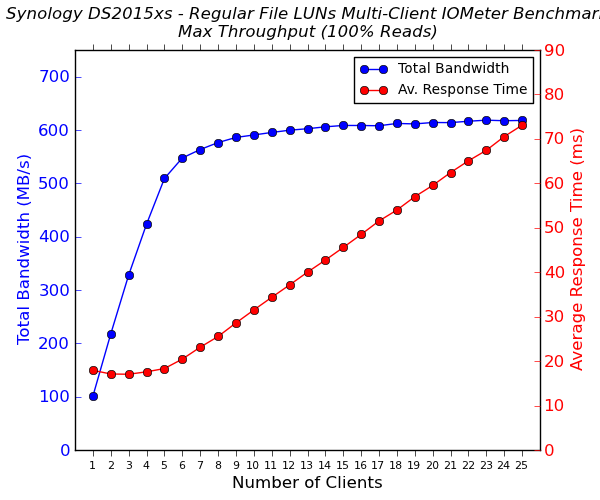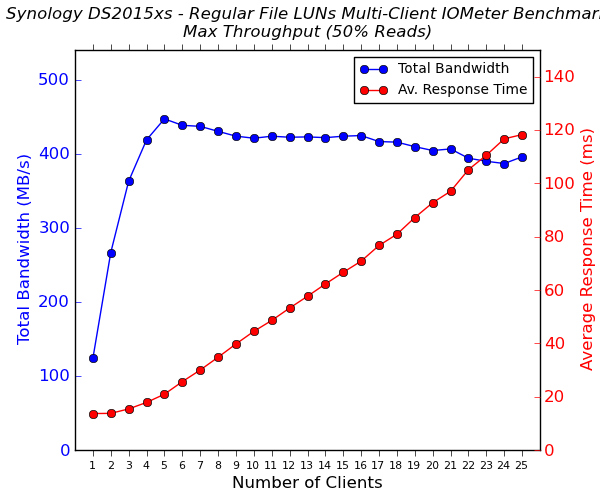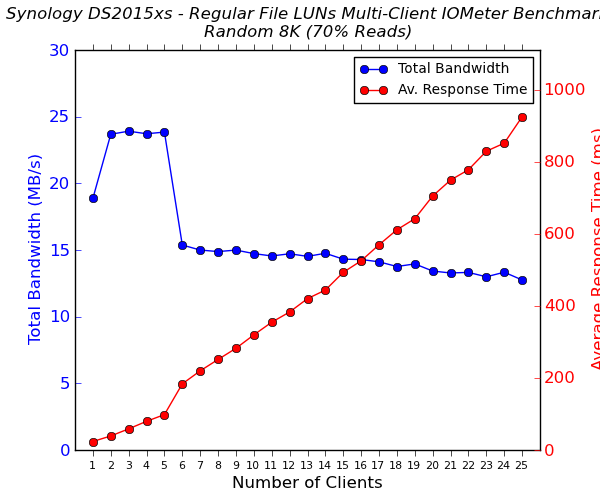Synology DS2015xs Review: An ARM-based 10G NAS
by Ganesh T S on February 27, 2015 8:20 AM EST- Posted in
- NAS
- Storage
- Arm
- 10G Ethernet
- Synology
- Enterprise
Multi-Client iSCSI Evaluation
As virtualization becomes more and more popular even in home / power user settings, the importance of the iSCSI feature set of any COTS NAS can't be overstated. Starting with our ioSafe 1513+ review, we have started devoting a separate section (in the reviews of NAS units targeting SMBs and SMEs) to the evaluation of iSCSI performance. Since we have already looked at the way iSCSI LUNs are implemented in DSM in the ioSafe 1513+ review, it won't be discussed in detail.
We evaluated the performance of the Synology DS2015xs with file-based LUNs as well as configuring a RAID-5 disk group with single as well as multiple LUNs. The standard IOMeter benchmarks that we used for multi-client CIFS evaluation were utilized for iSCSI evaluation also. The main difference to note is that the CIFS evaluation was performed on a mounted network share, while the iSCSI evaluation was done on a 'clean physical disk' (from the viewpoint of the virtual machine).
Performance Numbers
The four IOMeter traces were run on the physical disk manifested by mapping the iSCSI target on each VM. The benchmarking started with one VM accessing the NAS. The number of VMs simultaneously playing out the trace was incremented one by one till we had all 25 VMs in the fray. Detailed listings of the IOMeter benchmark numbers (including IOPS and maximum response times) for each configuration are linked below:
- Synology DS2015xs - 8 SSDs / RAID-5 / 2x 10G - LUNs (Regular Files)
- Synology DS2015xs - 8 SSDs / RAID-5 / 2x 10G - Single LUN on RAID
- Synology DS2015xs - 8 SSDs / RAID-5 / 2x 10G - Multiple LUNs on RAID




The observations we had in the previous section hold true here also. In general, the performance of the DS2015xs iSCSI volumes is better than the others that are presented as comparison points, even considering the SSD vs. HDD aspect.










49 Comments
View All Comments
Dug - Saturday, February 28, 2015 - link
Actually RAID 10 is used far more than RAID 5 or 6. With RAID 5 actually not even being listed as an option with Dell anymore.The random write IOPS loss from RAID6 is not worth it vs RAID10.
Rebuild times are 300% faster with RAID10.
The marginal cost of adding another pair of drives to increase the RAID10 array would be easier than trying to increase IO performance later on a RAID6 array.
But then again, this is mostly for combining os, apps, and storage (VM). For just storage, it may not make any difference depending on the how many users or application type.
SirGCal - Sunday, March 1, 2015 - link
That's missing the point entirely. If you lose a drive from each subset of RAID10, you're done. It's basically a RAID 0 array, mirrored to another one (RAID 1). You could lose one entire array and be fine, but lose one disk out of the working array and you're finished. The point of RAID 6 is you can lose any 2 disks and still operate. So most likely scenario is you lose one, replace it and the rebuild is going and another fails.RAID0 is pure performance, RAID1 is drive for drive mirroring, RAID10 is a combination of the two, RAID 5 offers one drive (any) redundancy. Not as useful anymore. RAID 6 offers two. The other factor is you lose less storage room with RAID 6 then RAID 0. More drive security, less storage loss. More overhead sure but that's still nothing for the small business or home user's media storage. So, assuming 4TB drives x 8 drives... RAID 6 = 24TB or usable storage space (well, more like 22 but we're doing simple math here). RAID 10 = 16TB. And I'm all about huge storage with as much security as reasonably possible.
And who gives a crap what Dell thinks anyhow? We never had more trouble with our hardware then the few years the company switched to them. Then promptly switched away a few years after.
DigitalFreak - Monday, March 2, 2015 - link
You are confusing RAID 0+1 with RAID 10 (or 1+0). http://www.thegeekstuff.com/2011/10/raid10-vs-raid...0+1 = Striped then mirrored
1+0 = Mirrored then striped
Jaybus - Monday, March 2, 2015 - link
RAID 10 is not exactly 1+0, at least not in the Linux kernel implementation. In any case, RAID 10 can have more than 2 copies of every chunk, depending on the number of available drives. It is a tradeoff between redundancy and disk usage. With 2 copies, every chunk is safe from a single disk failure and the array size is half of the total drive capacity. With 3, every chunk is safe from two-disk failure, but the array size is down to 1/3 of the total capacity. It is not correct to state that RAID 10 cannot withstand two-drive failures. Also, since not all chunks are on all disks, it is also possible that a RAID 10 survives a multi-disk failure. It is just not guaranteed that it will unless copies > 2. A positive for RAID 10 is that a degraded RAID 10 generally has no corresponding performance degradation.questionlp - Friday, February 27, 2015 - link
There's the FreeNAS Mini that can be ordered via Amazon. I think you can order it sans drives or pre-populated with four drives. I've been considering getting one, but I don't know how well they perform vs a Syn or other COTS NAS boxen.usernametaken76 - Friday, February 27, 2015 - link
iXsystems sells a few different lines of ZFS capable hardware. The FreeNAS Mini which was mentioned wouldn't compete with this unit as it is more geared towards the home user. I see this product as more SOHO oriented than consumer level kit. The TrueNAS products sold by iXsystems are much more expensive than the consumer level gear, but you get what you pay for (backed by expert FreeBSD developers, FreeNAS developers, quality support.)zata404 - Sunday, March 1, 2015 - link
The short answer is no.bleppard - Monday, March 2, 2015 - link
Infortrend has a line of NAS that use ZFS. The EonNAS Pro 850 most closely lines up with the NAS under review in this article. Infortrend's NAS boxes seem to have some pretty advanced features. I would love to have Anandtech review them.DanNeely - Monday, March 2, 2015 - link
I'd be more interested in seeing a review of the 210/510 because they more closely approximate mainstream SOHO NASes in specifications; although at $500/$700 they're still a major step up in price over midrange QNap/Synology units.It's not immediately clear from their documentation, I'm also curious if they're running a stock version of OpenSolaris that allows easy patching from Oracle's repositories, or have customized it enough to make customers dependent on them for major OS updates.
DanNeely - Monday, March 2, 2015 - link
Also of interest in those models would be performance scaling to more modest hardware, the x10 units only have baytrail based processors.